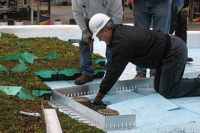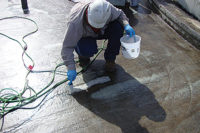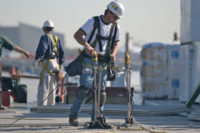Roof systems last a long time. Some last longer than others, but why? RoofPointTM, the Guideline for Environmentally Innovative Nonresidential Roofing, provides a number of ideas about improving durability and longevity of a roof system.
First, proper roof system design and installation start with code compliance. Roofs need to meet the minimum requirements for weather protection, performance, fire resistance, materials and coverings, insulation and re-roofing listed in the minimum requirements for weather protection, performance, fire resistance, materials and coverings, insulation and re-roofing listed in Chapter 15 of the International Building Code or Chapter 9 of the International Residential Code. Code requirements are legal minimums; there are many ways to design and install roofs well above the minimum legal requirements. Here are some ideas.
Use a roof cover board. Cover boards made from high-density wood fiber, perlite, moisture-resistant gypsum board or high-compressive foam insulation provide toughness to help protect the membrane and primary thermal insulation system from external impacts (e.g., hail, foot traffic). Cover boards also add some additional R-value, as well as improve thermal efficiency when adhered so insulation fasteners are separated from the bottom side of the membrane.
Provide for effective drainage. Roofs systems are not intended to hold water; codes require minimum slope for drainage. Drains and scuppers need to be sized to meet the requirements in the International Plumbing Code. While most roofs have effective overall drainage, localized drainage is sometimes overlooked. Tapered insulation on the upslope side of rooftop equipment and between scuppers is important to prevent localized ponding. Water on roof, in conjunction with UV rays, damages and deteriorates roof membranes. And ponded water can void a warranty, too.
Install traffic protection. Other trades invariably use the rooftop. Walk pads, pavers, walkway membrane rolls or elevated walkways should be placed around any location that receives periodic maintenance. And these locations should be connected to each other and to scuttles, hatches and access doors via the shortest path.
Increase wind resistance. Roof systems need to meet minimum wind resistance requirements mandated by the codes; however, designing a roof to a higher-than-code wind speed (e.g., add 10 or 20 mph) will greatly enhance durability and longevity. The wind resistance of edge metal and copings can be upgraded by using thicker metal or adding fasteners.
Determine if a vapor retarder is needed. Building envelope components go through a wetting and drying process, primarily because of vapor drive. It’s important to understand that a building’s use, roof system design and geography affect the wetting and drying cycle of a roof system. A vapor retarder may be required to prevent moisture from entering a roof system, thereby preventing a roof from becoming and staying wet. Vapor in a roof can condense and lead to degradation, loss of R-value and biological growth. Also, the location of the vapor barrier is important to its success.
Manage moisture during installation. Keeping materials dry before they are installed prevents unwanted moisture from being built into a roof. Using tarps and elevating materials on pallets can keep materials from getting wet. End-of-day tie-offs prevent moisture infiltration into the completed roof. Keeping materials dry prevents premature deterioration and unwanted biological growth. Remember, we build outside; keeping materials dry prevents damage in the future.
A number of additional enhancements can improve durability and longevity of a roof system. These include using a fully protected membrane, installing redundant laps/seams, using additional interplies, installing sacrificial layers (around vents that exhaust oils or chemicals; or under support pads [e.g., for rooftop PV]), adding an extra coating layer and using a membrane with increased thickness.
The roofing industry knows good design, quality materials, proper installation and regular maintenance are needed to achieve a successful roof. To help ensure a quality installation, a quality management program can make certain the installation follows best practice means and methods, as well as manufacturer requirements. Additionally, regular roof maintenance is critical for longevity and durability. For more on roof maintenance, read the June 2014 Sustainable Roofing column. More information about longevity and durability is contained in the RoofPoint Guidelines, which are available at www.roofpoint.org. By the way, have you submitted a RoofPoint project recently? Consider doing so, and take advantage of the marketing opportunities.







Report Abusive Comment